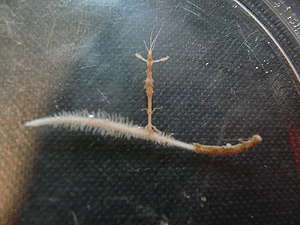Happy days at the microlaboratory
04.08.2008 The waves won’t stop rolling, even though the sun is shining from a quite bright sky. Therefore this is yet another day without ROV-dives. More samples are taken up by the other instruments, from proximally the same area as yesterday.

Main content
We are about 64 degree N and 5 degree E, in the Norwegian Sea outside the coast of Trøndelag. If we had sailed southeast, we had struck Hitra, an island which is located southwest of Trondheim. All of this area, which lies between us an shore, has depths up to 3-400 meters, while the areas where the sampling is taken are up to 7-800 meters and dropping rapidly as we are moving westward. We are in other words, searching in a slope. On the map we can see lines crossing and some broader grey fields. This is the login the geologists do with help of, among other things, TOPAS. Then, they can see where they already have been and use this information later.
The macrobiologists are based on their own laboratory where they sort and analyze samples from the box- and multicore-depending on who is to examine the sediments. Michael Cid and Daria Portnova are mainly interested in animals and plankton less than 2 millimeters and can find these both in samples from box- and multicore. We have previously mentioned that Michael Cid examines foraminifera, while Daria mapping all the other species that are less than 2 millimeters. Daria takes her samples with an adjusted syringe, and then she can sort the results in a given volume. Through a microscope, she shows us the art of polychaet, it is also called sea worm and is a part of jointed worms. As the name suggests, a lot of the species are living in the ocean, and most of them are characterized by the fact that they wear many "brushes", that is a kind of special hair.
Christiane Todt examining the animals larger than 2 millimeters and find her samples in the boxcore. She is looking for small animals in the seafloor sediments, and register diversities (different types of species) and quantity (numbers of species). She also hopes to find new species. Here she shows us a ghost shrimp.
When the macrobiologists work, they first of all take samples from the sediments in different ways. Some use customized syringes, others with slightly bigger equipment. Then they sight the samples through sieves of various sizes. They take care of the water and the sediments that go through the sieve. It begins with the biggest sieve with a grid of 1 millimeter clearance and ends with the finest sieve with a grid of 32 micrometer range. Different species get sighted and there are only bacteria and the color of the sediments that are allowed passage through the finest sieve.
The weather report promise better weather tomorrow, the rest of the day is used to mapping the seafloor using TOPAS. During the night, some goes to the cinema, other to the gym and others to their cabin. The biologists clean up and wash their equipment, register and sort samples that were taken earlier. Yifeng's attention is concentrated on the samples she has taken from a gravitycore. For her, this is a tedious process. When she places the syringes down in the sediments, they have to stay put for four hours. When she goes to bed, several of us already had hours of sleep. We hope the weather will be better tomorrow, if not, the ROV have to stay on the boat tomorrow as well.
